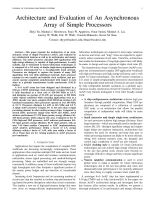 PDF (0.6 MB),
(c) Copyright, 2008 Springer.
The official version publication is available at
www.springerlink.com
PDF (0.6 MB),
(c) Copyright, 2008 Springer.
The official version publication is available at
www.springerlink.com
This paper presents the architecture of an Asynchronous Array of
simple Processors (AsAP),
and evaluates its key architectural features
as well as its performance and energy efficiency.
The AsAP processor calculates DSP applications with high
energy-efficiency, is capable of high-performance, is easily scalable,
and is well-suited to future fabrication technologies.
It is composed of a 2-D array of simple single-issue programmable processors
interconnected by a reconfigurable mesh network.
Processors are designed to capture the kernels of many DSP algorithms with
very little additional overhead.
Each processor contains its own tunable and haltable clock oscillator,
and processors operate completely asynchronously with respect to each
other in a globally asynchronous locally synchronous (GALS) fashion.
A 6x6 AsAP array has been designed and fabricated in a
0.18 μm CMOS technology.
Each processor occupies 0.66 mm2,
is fully functional at a clock rate of 520-540 MHz at 1.8 V,
and dissipates an average of 35 mW per processor at 520 MHz under
typical conditions while executing applications such as a JPEG
encoder core and a complete IEEE 802.11a/g wireless LAN baseband transmitter.
Most processors operate at over 600 MHz at 2.0 V.
Processors dissipate 2.4 mW at 116 MHz and 0.9 V.
A single AsAP processor occupies 4% or less area than a single
processing element in other multi-processor chips.
Compared to several RISC processors (single issue MIPS and ARM),
AsAP achieves performance 27-275 times greater,
energy efficiency 96-215 times greater,
while using far less area.
Compared to the TI C62x high-end DSP processor,
AsAP achieves performance 0.8-9.6 times greater,
energy efficiency 10-75 times greater,
with an area 7-19 times smaller.
Compared to ASIC implementations,
AsAP achieves performance within a factor of 2-5,
energy efficiency within a factor of 3-50,
with area within a factor of 2.5-3.
These data are for varying numbers of AsAP processors per benchmark.
 PDF (0.6 MB),
(c) Copyright, 2008 Springer.
The official version publication is available at
www.springerlink.com
PDF (0.6 MB),
(c) Copyright, 2008 Springer.
The official version publication is available at
www.springerlink.com
Zhiyi Yu, Michael Meeuwsen, Ryan Apperson, Omar Sattari, Michael Lai, Jeremy Webb, Eric Work, Tinoosh Mohsenin, Bevan Baas, "Architecture and Evaluation of an Asynchronous Array of Simple Processors," Journal of Signal Processing Systems, March 2008.
@article{VCL:VLSI.Sig:2008,
author = {Zhiyi Yu, Michael Meeuwsen, Ryan Apperson, Omar Sattari,
Michael Lai, Jeremy Webb, Eric Work, Tinoosh Mohsenin, Bevan Baas},
title = {Architecture and Evaluation of an Asynchronous Array of Simple
Processors},
journal = {Journal of Signal Processing Systems},
volume = 53,
number = 3,
pages = 243--259,
month = mar,
year = 2008
}
Last update: April 03, 2008